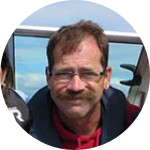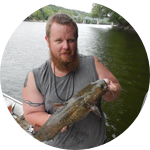About This Project
The Wabash River is a 500-mile long river in Indiana. Historically the river was used as a dumping site for industrial and sewage wastes. We hypothesize that there was a substantial shift in fish populations around 1995 from invasive Silver Carp (Hypophthalmichthys molitrix) and agriculture. The goal of this project is to use stable isotope analyses to compare what fish were eating before 1995 with today. We will generate a food web showing how Silver Carp and agriculture affected the ecosystem.
Ask the Scientists
Join The DiscussionWhat is the context of this research?
Food web relationships are important for healthy ecosystems. Increased nutrients from agriculture and sewage releases in the Wabash River increase nitrogen, resulting in elevated algae production. Because the herbivorous fish consume algae, this change can affect the entire food web.
Silver Carp is one of the Asian carp that were introduced in the Wabash River around 1995. These carp were brought to the US for aquaculture in ponds, and escaped into the Mississippi River during floods. There are few studies on the effects of Silver Carp, but we believe they impact the river ecosystem. In this project we will identify the current and historic food webs of the Wabash River to identify how populations of fishes have changed since the introduction of Silver Carp and changes in nutrients.
What is the significance of this project?
Understanding river ecosystems functions is useful to detect and avoid fish mortality and to manage rivers for human needs. High nutrient levels cause algae blooms that can be toxic to river organisms, although it is unknown how these algal blooms modify food webs. A common characteristic of food webs is for changes in organisms at the base of food chains to affect organisms at higher food web levels. Detailed food web connections can be identified using stable isotope technology. Carbon and nitrogen occur in several isotope forms. We can analyze a small sample of animal tissue for carbon isotope ratios to identify the energy source for organisms in a food web; and nitrogen isotope ratios tell us the number of food web levels for that animal.
What are the goals of the project?
We will collect consumer and predator fishes in the Wabash River. This includes fishes that eat algae and fishes that eat other fishes. We will construct food webs using these species.
For food webs from the past, we will use preserved specimens from natural history museums such as the Illinois Natural History Survey.
Tissue samples will be analyzed using amino-acid stable isotope methods. By analyzing the 15N/14N ratio of amino acids we can determine the original algal signature (from phenylalanine) and the number of trophic transfers (from glutamic acid).
This information will tell us diets for each fish. We will know if the fish were eating green algae, blue-green algae, aquatic plants, or terrestrial plants. We expect to identify diet effects from algal blooms and/or Silver Carp.
Budget
Baseline Funding: Fishes will be collected by boat electrofisher, a boat with a generator and probes hanging into the water (owned by Ball State University). Three scientists including me will collect 5 of each species: Gizzard Shad, Freshwater Drum, Blue Sucker, River Carpsuckers, Spotted Bass, and Longnose Gar. These are important fishes in the Wabash River food web. Gizzard Shad eat algae and leaf detritus. Freshwater Drum, Blue Sucker, and River Carpsucker eat insects and snails on the river bottom. Spotted Bass and Longnose Gar eat fish.
Amino acid stable isotope analyses will be processed at the University of California Davis Stable Isotope Laboratory. A food web based on historic fish samples (pre-1995) will be compared to a food web for current fish samples, to identify if Silver Carp and/or changes in plant / algae alter the food webs.
Endorsed by
Meet the Team
Mark Pyron
Ecological research gets me out of the office into the real world. My favorite research projects are in attractive or exotic locations including the western US, Mongolia, and the tropics where we are collecting river fishes for constructing similar food webs. My students interests drive my laboratory -- they provide the motivation and energy to complete projects.
Robert Shields
Robert is a PhD student at Ball State University. His research is on river fishes and their food webs.
Lab Notes
Nothing posted yet.
Additional Information
We use a boat electrofisher to collect fishes on the Wabash River.
Students help with field work. This is a shovelnose sturgeon, a fish that eats insects, snails, and clams on the bottom of the river.
Sauger is an example of a predator fish.
This is an example of the Wabash River food web.
Project Backers
- 3Backers
- 1%Funded
- $28Total Donations
- $9.33Average Donation


